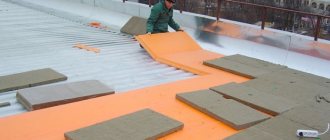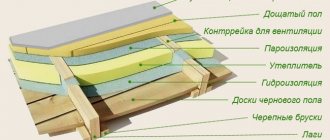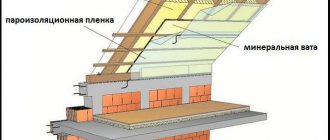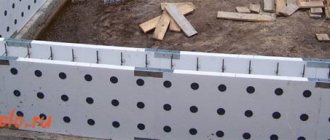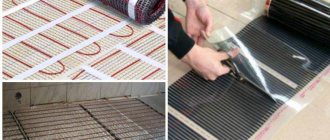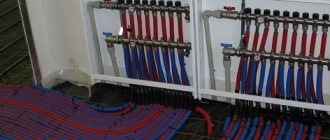What are the consequences of excess moisture in the soil?
You can see the results of this phenomenon yourself - trees and shrubs die. Why is this happening?
- the oxygen content in the soil decreases and the carbon dioxide content increases, which leads to disruption of air exchange processes, water regime and nutritional regime in the soil;
- oxygen starvation of the root-forming layer occurs, which leads to the death of plant roots;
- the supply of macro and microelements by plants (nitrogen, phosphorus, potassium, etc.) is disrupted, because excess water washes out mobile forms of elements from the soil, and they become unavailable for absorption;
- intensive breakdown of proteins occurs and, accordingly, the processes of decay are activated.
Plants can tell you at what level groundwater lies
Take a close look at the flora of your area. The species inhabiting it will tell you at what depth the groundwater layers are located:
- perched water - it is best to dig a reservoir in this place;
- at a depth of up to 0.5 m - marigold, horsetails, varieties of sedges grow - bladderwrack, holly, foxtail, Langsdorff's reed;
- at a depth of 0.5 m to 1 m - meadowsweet, canary grass, ;
- from 1 m to 1.5 m – favorable conditions for meadow fescue, bluegrass, mouse peas, rank;
- from 1.5 m - wheatgrass, clover, wormwood, plantain.
What is important to know when planning site drainage
Each group of plants has its own moisture needs:
- with a groundwater depth of 0.5 to 1 m, vegetables and annual flowers can grow in high beds;
- depth of water layer up to 1.5 m is well tolerated by vegetables, grains, annuals and perennials (flowers), ornamental and fruit shrubs, trees on a dwarf rootstock;
- if the groundwater is more than 2 m deep, fruit trees can be grown;
- The optimal depth of groundwater for agriculture is from 3.5 m.
Is site drainage necessary?
Record your observations for at least some time. You yourself can understand how much drainage is needed.
Maybe it makes sense to simply redirect melt and sediment water along the bypass channel, rather than allowing it to flow through your site?
Perhaps it is necessary to design and equip a storm drain and improve the composition of the soil and this will be enough?
Or is it worth making a drainage system only for fruit and ornamental trees?
A specialist will give you the exact answer, and we strongly recommend calling him. But after reading this article, you will gain some awareness on this issue.
Upon completion of the technological and production tasks associated with the arrangement of a sewer system in an apartment building, industrial building, as well as in a private household, it is necessary to test the involved system using the forced flow method. This task is used to identify possible defects or improper installation of the entire involved sewerage part, and the test report for internal sewerage and drainage systems will be material evidence of the work on acceptance of the facility.
A visual inspection should be accompanied by inclusion in the test report of internal sewerage and drainage systems according to SNIP, which is currently represented by the current regulations of the “D” series appendix, which corresponds to SP 73.13330.2012 “Internal sanitary systems of a building”, recently a new one has been applied updated working edition according to SNiP 3.05.01-85.
The vegetable pit is designed for storing vegetables and fruits. It is not difficult to build it with your own hands. Important criteria for saving the harvest are dryness and good air exchange. When creating conditions for a good microclimate, you must be wary of sudden temperature changes. Ventilation in the vegetable pit will help avoid unpleasant odors and stale air, as well as mold fungi.
What is it intended for and what characteristics should it have?
Fruit and vegetable products purchased or grown by yourself must be stored somewhere in the winter. Refrigerators are used to store winter preparations and fresh vegetables in small quantities. However, the refrigerator will not fit a bag of potatoes and several boxes of garlic and onions. Therefore, you have to independently build a special room where you can place the twists with vegetables. The microclimate in such cellars allows you to keep the crop fresh for 4-5 months.
The constructed storage facility must have the following features and characteristics:
- temperature readings should not exceed four degrees Celsius;
- the humidity level inside the cellar should be in the range of 90-95%;
- it should always be dark inside the vegetable pit, and therefore the lighting is turned on only in cases where there is a person inside;
- The cellar is equipped with a high-quality ventilation system that will ensure normal air circulation.
Cellar in the garage: what can you store?
If the cellar is made correctly: using heat and waterproofing materials, with forced or natural ventilation installed in it, with the construction of special shelves for storing food, then it can be stored in good condition until the end of spring as canned goods in jars and other containers and fresh vegetables: carrots, potatoes, beets, cabbage, etc.
In this case, not only the conditions created in the room are taken into account, but also the requirements for food storage . The lids should tightly close the jars, the potatoes should be placed in boxes with holes (if they are dry, they rot less), apples and large ranetkas should be wrapped in parchment paper, etc.
What does a cellar look like in a garage - photo:
Advantages
It makes sense to build a basement if the garage space is owned and expected to be used for many years. What are the advantages of a cellar in the garage?
- It is under lock and key. To get supplies for the winter, you first need to get into the garage. Therefore, “raids” of dubious individuals are excluded.
- The vegetable pit is located directly under the garage in a warm zone , so the cost of thermal insulation is minimal.
- Winter preparations and vegetables are close , just a stone's throw away. There is no need to go somewhere far to your summer cottage or dig out snowdrifts to provide access to the basement.
- The entrance to the cellar can be made directly from the inspection hole. Thus, 2 problems are solved: the workpieces are in the right place, and you can easily repair the car.
- With its compact size, such a room can become a storage facility for a large number of products .
- Since there is no need for a room for storing food supplies, the cellar can be easily converted into a workshop or storage room for things .
See the photo below for an example of a vegetable pit in the garage :
in excellent condition until late spring . But it is worth paying special attention to ventilation . Natural, usually consisting of 2 pipes, one of which is installed above the floor level, and the second above the ceiling, does not always save the situation. It would be better if these were modular systems controlled by a mini-computer. Then the conditions in the basement can be controlled artificially .
Sizing
Before equipping your garage space with a vegetable pit, you need to decide on its size.
When determining the area of the cellar, the thickness of the base and walls is taken into account. Also, when calculating the optimal area, it is taken into account that the size of the room for storing vegetables should be comfortable for the person inside. Therefore, experts advise digging a pit, the width of which will be 70-80 centimeters.
Since the pit should be located under the garage, its length directly depends on the length of the garage space, as well as on the number of products that will be stored in it. For example, if a cellar is built for a small amount of pickling, then its length can be 2-3 meters.
The minimum depth of the cellar for storing pickles is one and a half meters. However, if the owner of the premises is too tall, they dig a pit 160-170 centimeters deep.
Preparatory work
Having decided on a place to build a vegetable pit with your own hands, you need to prepare building materials. It is recommended not to make it too large, but to dig a vegetable storage area:
- width 2−2.5 m;
- no more than 1.7 meters deep.
You need to dig about 0.5-0.6 m away from the garage wall. This will then make it possible to better waterproof the structure.
Experts advise that you be sure to insulate the vegetable storage area and also provide ventilation in the vegetable pit. The internal part can be equipped at your discretion. A good cellar should have a reliable descent with comfortable and strong steps. It is usually covered with a hatch on top, which will serve as the entrance to the storage.
Selecting a location
A structure for storing supplies of vegetables and fruits should last for more than one year. For quality construction, you need to choose a suitable location. When carrying out such work, it is necessary to take into account some features. For example, the site must be on a hill so that groundwater does not fall into the hole, so the level of its occurrence is determined in advance.
You can check it yourself by drilling a well approximately 2.5 meters deep. They leave it in this form for several days and then check whether water appears there. If the place is dry, then you can safely begin arranging the storage. Another test option is to measure the depth of the adjacent wells.
Experienced craftsmen advise making a plan for yourself before starting construction. It will allow you to better navigate when performing work.
Site selection and subsequent planning
First, you will need to decide on the location where you plan to build a vegetable pit. Traditionally, it is installed under a storage room in a private house or under a garden house. Residents of apartment buildings have the opportunity to organize a convenient storage space by installing a vegetable pit in the garage.
It is important to note that despite the apparent simplicity of the design, simply digging a pit is not enough to arrange this type of cellar
If you are interested in information on how to make a vegetable pit, you need to take into account the following information
When planning construction, it is necessary to take into account a number of points:
In order not to damage an electrical cable or pipe accidentally lying in the ground, you will need to make sure that there are no utility lines laid in this location
From this point of view, it is more convenient to equip a hole in the basement or garage; it is necessary to determine the characteristics of the soil - it is important to collect information about the level of groundwater at the planned construction site (for this you may need to seek help from a specialist). In order for the structure to be sufficiently durable, it is necessary to select a place with a groundwater level below the bottom of the planned storage facility - at least half a meter
If they are located close enough, this problem should not be ignored - in this case, you will need to equip a reliable waterproofing system (otherwise you may end up with a vegetable pit that is regularly flooded with water). Such an arrangement will entail significant financial and labor costs, and water may still find a loophole and eventually seep inside; in the vegetable storehouse you will need to ensure suitable temperature and humidity conditions. To ensure that the fruits do not wrinkle or dry out, a humidity of 85-95% is optimal, as well as a temperature slightly above zero (from 2 to 5°C). Storage under these conditions will protect products from spoilage and allow them to retain maximum nutrients. A thermometer placed there will help you monitor the temperature in the vegetable pit; to ensure the flow of fresh air into the storage facility, it is necessary to equip it with ventilation - bring the supply and exhaust pipes outside; In addition, to prevent vegetables from sprouting during storage, the room must be kept dark.
How to store potatoes if there is no cellar
There are many different ways to store potatoes in winter: in the ground, cellar, basement, on the balcony . One of the oldest and most effective is storing potatoes in the ground. All necessary conditions for temperature and humidity are created in the soil to ensure high-quality storage.
There are also several ways to store it in the ground: in a hole, trench or pile. By creating such a storage facility, you can save the harvest until spring.
Important! It is recommended to periodically sort through the harvest sent for storage in order to weed out good potatoes from damaged tubers. If this is not done, then even one low-quality potato can cause massive rotting of the entire crop.
Pit storage
How to bury potatoes in the ground for the winter? A pit is a simple storage for potatoes, equipped directly in the ground. On a plot of land, they dig a hole of the required size and depth of 0.7-1.5 m. The depth depends on the region of residence and the severity of the frost, that is, on how much the ground freezes.
The bottom of the pit is lined with boards so that the tubers do not lie on bare ground. The top of the pit is also covered with boards, sprinkled with a layer of earth and covered with materials with thermal insulation properties - for example, straw or sawdust.
Often such improvised cellars are equipped with ventilation. Before forming the roof of the pit, a plastic pipe is inserted inside to ensure air exchange.
Important! The top of the ventilation pipe must be protected from precipitation or possible blockages.
Storage in trenches and piles
These methods are based primarily on the properties of the soil. Insufficient thermal conductivity and gas exchange in the soil create optimal conditions (temperature, humidity level) in trenches and piles to preserve the quality of the crop.
The dimensions and depth of such storage facilities, similar to a pit, depend on geographic latitude. The harsher the winter, the deeper the trenches and piles are dug.
In southern latitudes, trenches are more often used for storing potatoes, cabbage, and beets. Burts are more common in the north. Not only potatoes are left there for the winter, but also carrots, cabbage, beets, celery and other vegetables.
Burt with your own hands
This method involves storing the crop directly on the ground and creating a protective layer on top. They try to place the pile in a place protected from cold winds with a groundwater level no closer than 2 m from the laying site.
To protect the collar from water leakage, drainage channels are made along the perimeter of the storage facility. To prevent autumn and spring surface water from stagnating at the storage site, drainage ditches are dug at a distance of 50 cm from the shelter.
The tubers are stacked in the form of a pyramid no more than 1.5 m high. The potatoes are covered with insulation (straw) on top, which is sprinkled with a layer of earth. It is important that the layer of earth at the edges is thicker than at the top of the pile.
STORING POTATOES IN BURPLES
DIY trench
A trench is dug of any length, no more than 1 m wide and 0.7 to 1.5 m deep, depending on the degree of freezing of the ground. They make a trench on a hill so that the crop does not flood.
After the tubers are lowered into the trench, they are covered with heat-insulating material: spruce branches, straw, sawdust. This layer reaches the edges of the trench. The top of the trench is covered with a layer of earth 0.3-0.4 m.
Storage in a trench does not require additional ventilation, since there will be more than enough oxygen in the soil.
Arranging a vegetable pit make the cellar ideal
A pit for storing crops in a garage, as we said, must be waterproofed. You may even have to make a circular drainage system in the cellar. Such measures are carried out in cases where groundwater is close to the bottom of the vegetable storage facility.
Waterproofing pits for harvest storage
The easiest way to protect the floor surface of a vegetable pit from moisture is as follows:
- treat the floor with bitumen solution (twice to be safe);
- lay sheets of roofing felt on the bitumen;
- reapply the solution;
- make a filling on the roofing material using coarse sand.
The walls of the storage facility can also be coated with bitumen or more expensive penetrating waterproofing can be used.
The final touch is installing ventilation in the basement. The easiest way is to make a natural supply and exhaust system. To do this, you will need to place two pipes (for exhaust and fresh air) at a certain height from the floor. Installation of forced ventilation will require more costs. You will need to buy a special electric fan and place it in a pipe with two doors. Your cellar for storing vegetables is ready!
This is interesting: How many bricks are needed for a garage - we will write it down in detail
Forced ventilation of vegetable pit
If the vegetable pit is located in the garage, you should give preference to forced air exchange. The arrangement of such ventilation involves the installation of not only air ducts, but also fans.
Device algorithm
- An air duct is installed near the ceiling of the pit to remove air. The end of this pipe should be 0.5 m above the roof level of the garage.
- At the very bottom of the vegetable pit, at a distance of 10 cm from the floor, a supply branch channel is installed. It extends outward 0.25 cm, connects to a 90° elbow, and is led out through the wall at the bottom of the building to the street.
- With forced ventilation, this circuit is enhanced by fans. The performance of mechanical devices must correspond to the volume of the ventilated room.
- A good option may be a combination of natural and forced air exchange systems. To do this, an exhaust fan is installed in the ventilation duct intended for air removal. It creates an air vortex, forcing air currents out of the vegetable pit. Consequently, while ensuring an influx of fresh air from the supply ventilation duct.
Construction stages
If you are installing a constructed pit on an open plot of land, and not in a finished garage or basement, first dig a pit of the required size.
Digging a hole for storing fruits and vegetables is not difficult. It is much more difficult to equip it correctly. When constructing a vegetable storage facility, it is necessary to take into account the issues of arranging walls and floors, organizing hydro- and thermal insulation, and ensuring ventilation.
Arrangement of floors, walls, ceilings
How to make a vegetable pit from concrete rings? At the bottom of the vegetable pit in the garage, 10 cm of crushed stone and 15 cm of sand are placed from concrete rings. Each layer must be compacted well. After preparation, all layers should be filled with bitumen or another substance with similar properties.
Natural ventilation in a vegetable pit
A vegetable pit can be built in a garage or outdoors. If it is located in a garage, it will most likely be divided by a partition with an inspection hole. However, wherever it is built, it is necessary to consider the ventilation system. An important point is the material from which it was constructed. It could be:
- wood;
- concrete plates;
- brick.
High-quality natural ventilation of vegetable pits largely depends on the insulation of the room.
The simplest option, if the pit is located on the street, may be to install two air ducts of the same cross-sectional diameter. They should be installed in opposite corners. The ventilation duct for air supply is mounted at a distance of 0.2 m from the floor. This duct will pass through the ceiling. From the outside, the pipe must rise above the ground surface by at least 0.2 m. The exhaust pipe is mounted under the ceiling in the ceiling. It is brought out as high as possible from the ceiling surface.
Thanks to the inflow and outflow of air through the ventilation ducts, natural air circulation will occur. It is based on the difference in pressure inside and outside the room. If there is severe frost outside in winter, the ventilation is blocked using dampers.
The only disadvantage of natural air exchange is its dependence on weather conditions. In the warm season, the air can stagnate due to the lack of normal draft. Another important point is to protect ventilation pipes from pests and precipitation. In the first option, you can use a mesh, in the second, a special umbrella made of metal or plastic.
Waterproofing vegetable pit
Stage 1. Surface preparation
- Remove loose concrete mechanically (using a jackhammer, hammer drill or high-pressure apparatus (HPR) type KARCHER).
- Clean the concrete surface using a brush with metal bristles from dust, dirt, cement laitance, tile adhesive, paint and other materials that prevent the penetration of active chemical components into the concrete.
- Along the entire length of cracks, seams, joints, abutments and around the communications entry, make dovetail-shaped fines with a depth of 30 and an outer width of 20 mm. With severely damaged concrete, the size of the fine increases.
- Clean the scratches with a brush with metal bristles, a high pressure brush.
- If reinforcement is exposed, remove sufficient concrete behind the reinforcing bars until they are completely clear. Remove rust mechanically or chemically (to bare metal) and apply an anti-corrosion coating (mineral, epoxy or zinc) before using the material or
Stage 2. Waterproofing of structural elements
b) joints, cracks.
- Moisten the groove thoroughly.
- Prepare a solution of the material
- Fill the hole tightly with it (with a hole 20 X 30 mm, material consumption 1.35 kg/m.p.)
The material has a penetrating effect, so the groove under it does not require pre-treatment with penetrating compounds, which distinguishes the KT Tron line of materials from other brands.
Stage 3. Application of waterproofing coating
Waterproofing concrete with a penetrating compound:
- Thoroughly moisten the concrete surface.
- Prepare a solution of waterproofing material and apply it in two layers with a synthetic fiber brush.
- Apply the first layer to damp concrete with a brush, applying strokes in one direction (without smearing).
- Before applying the second layer, moisten the surface. Apply the second layer on a fresh, but already set first layer. It is recommended to apply the layers in perpendicular directions.
- Calculation of the material for two-layer application on a smooth surface is 0.8 kg/m2, on a rough surface - 1.0 kg/m2.
Stage 4. Surface care
It is necessary to ensure that the surfaces treated with waterproofing materials of the KT Tron system remain wet for 3 days, that cracking and peeling of the coating should not be observed, and that the temperature regime is maintained.
To moisten treated surfaces when waterproofing vegetable pits, the following methods are usually used: water spraying, covering the concrete surface with plastic film.
Preface
. Self-waterproofing of an inspection pit in a garage is a whole complex of works that are aimed at protecting the structure from moisture from the soil. But what materials to choose, how to waterproof the inspection pit and carry out the installation correctly? This article, which contains only information verified by our own experience, will tell you about all this and show it on video.
Every car owner wants his iron horse to serve for a long time, and for this it is necessary to provide the car with timely repairs and maintenance. Many car enthusiasts, based on their experience, prefer to do minor repairs in the garage themselves. And this requires a garage equipped with tools and accessories.
Pit construction
After careful planning, you can begin building your own vegetable pit.
The first step is to dig a pit for the future cellar. Then you need to dig a trench in it in which the foundation will be installed. Crushed stone is poured onto the bottom (the thickness of its layer should be at least ten centimeters), and on top of it - construction sand in a layer of fifteen centimeters. Both levels need to be properly compacted and leveled. Then you can fill the base with heated bitumen or another similar composition. If you want to make the storage very reliable, you can put a waterproofing material - for example, roofing felt - directly on the sand and cover it with reinforced concrete on top. However, such work will be more labor-intensive and cost much more. Not all cases require such powerful waterproofing. Sometimes wooden planks are placed on the floor on top of the concrete.
After the floor in the vegetable pit of a garage or private house is filled, you can move on to the walls. They are most often built from concrete or brick. The following requirements are established for them:
- for strength, concrete must be tied with steel reinforcement rods;
- the brickwork should be at least half a brick thick, but better - a whole brick or even one and a half.
The strength of the ceiling is especially important if there is any building above the cellar. Having made a vegetable pit in the garage, it is worth remembering that a car will be standing above it. In the case of a private house, everything is even more serious. If the area at the top is empty, then the requirements for the structure are somewhat reduced - the main thing is that it is reliable and does not collapse down.
The ceiling can be laid out either from bricks laid on boards, or from concrete - in this case you will need a frame made of reinforcement. At this stage, it is necessary to provide all the required openings: the entrance where the ladder and hatch will be installed, and the ventilation passage points. The most convenient place for a crawl space is the center of the underground. In this case, all the walls will remain free, along which it will be possible to install many shelving units. The final stage is insulating the ceiling. To do this, it is coated with bitumen and thermally insulated with foam plastic or expanded clay.
Do-it-yourself water heating in a private house and its installation
Recommendations for carrying out work
If you are wondering how to make a vegetable pit with your own hands, then it is important to think about thermal insulation of the upper part of the cellar. The insulation layer must be 20 centimeters or more thick. You can take advantage of the experience of rural residents who insulate the ceiling of such storage facilities using a mixture of cement and sawdust. As an alternative solution, glass wool can be used. If the garage is built in an area with a mild climate, then thermal insulation may not be provided. If you need to give the ceiling surface of the pit an attractive appearance, you can use the method of installing modern facing materials such as lining or slate. These products are fixed to the ceiling surface using the technology recommended by the manufacturer. The walls need to be thermally insulated with polystyrene foam. The vegetable pit in the garage is made with your own hands in such a way that the insulation is carried out over a pre-plastered surface.
How to design a vegetable pit in the garage with your own hands
To build a vegetable pit correctly, you will have to understand the main stages of construction.
We build a hole
The cellar begins to be created by digging a pit in which a basement will be built for storing vegetables and preserves. After this, the floor is arranged. To make the floor covering reliable, it is made of several layers. First, the bottom is covered with a small layer of crushed stone, which is compacted with a vibrating plate. Then the compacted crushed stone is covered with construction sand and filled with concrete.
When the flooring has hardened, the walls are finished. A solid brick that is resistant to high humidity is suitable for this. The walls are laid out in such a way that the seams of each subsequent row of bricks do not coincide with the previous one.
After creating the walls, a reliable ceiling is created that can withstand any load. When making a ceiling, boards are laid at the top of the pit, on which reinforcement is laid and concrete is poured. Having finished with the ceiling, you can make a staircase, which is installed near the entrance inside.
Drainage
Before using the vegetable pit, dry the room so that the walls, ceiling and floor are completely dry. There are several methods that help dry out the cellar:
- Place a metal bucket in the center of the basement, fill it with firewood and build a fire. When using this method, you will have to maintain the fire for an hour and a half.
- Place a metal pipe outside and place a burning candle underneath it, which will provide natural draft.
Waterproofing
Sometimes vegetable pits are made in areas with high groundwater levels, which increase humidity. In this case, you need to install waterproofing inside the basement, which will help keep the humidity level within normal limits.
Choice of insulation
To maintain the optimal temperature inside the cellar, additional thermal insulation will be needed. The selected thermal insulation material must have the following properties:
- environmental friendliness;
- chemical safety;
- reliability;
- protection from moisture.
To insulate storage for vegetables, use polystyrene foam or polystyrene foam.
Ventilation opening design
Any cellar must have ventilation, since it is responsible for the circulation of oxygen inside. When organizing a ventilation system, they install supply and exhaust pipes. The supply air is located near the floor, and the exhaust is led out through the roof.
Stages of building a brick vegetable pit with your own hands
After appropriate determination of the optimal location and direct digging, the most critical stage of work begins. It includes:
- construction of a pit;
- bricklaying;
- ventilation;
- insulation.
To insulate the room, you can use polystyrene foam.
Waterproofing a vegetable pit depends on the level of groundwater. At great depths, it is advisable to equip a circular drainage. Proper thermal insulation protects vegetables from temperature changes and keeps them from rotting. To achieve this, the walls are insulated on both sides. It is better to choose moisture-resistant slab insulation (expanded polystyrene).
Supply pipe arrangement
The correct location of the pipe is close, but not close to the cellar wall. The end of the channel will be approximately 20 - 50 centimeters from the floor. The end of the pipe must be led out through the foundation block of the garage. To protect the room from the penetration of rodents and other pests, a fine mesh mesh must be installed at the ventilation outlet. The exit should be located just above the foundation blocks, a little further than the main walls of the building. In this way, you can obtain an optimal flow of fresh air into the cellar. This scheme is used when organizing forced and natural ventilation.
Important tips when installing supply ventilation:
- The air intake should take place outside the walls of the garage or other room, preferably away from the gate, so that when entering the pipe, exhaust gases do not enter. You can consider an option so that the supply pipe is located further from the walls of the garage, but you need to think about placement without bends or right angles.
- You can make such a ventilation duct even at the stage of building the cellar. To do this, the space in the wall is limited in the brickwork, with dimensions of approximately half a brick. The masonry must be done according to all the rules, using the same mortar, but have a fairly large hole at the bottom, the end of which will be led out into the street through the garage block.
- The hole in the masonry wall or pipe must be at least 25 centimeters from the walls of the garage. This ensures normal air exchange.
- The diameter of the pipe also matters. Too small will not provide normal air flow, and a large diameter will make operation ineffective due to heat loss. The calculation can be taken as follows: for every cubic meter of room there should be at least 15 mm of pipe. Simple calculations will allow you to obtain a more or less correct section size. The same rules apply to the calculation of the exhaust pipe, so it is better that they are the same. This will additionally help to properly organize air exchange without unnecessary problems.
- For winter, it is necessary to provide insulation of the outer part of the pipe. For these purposes, you can use any insulating material, even rags. If it freezes regularly, you can think of a quick defrosting system, for example, insulating the end with non-flammable materials and building a fire under it.
- A damper must be provided from the inside of the supply ventilation to prevent food from freezing at negative outside temperatures. It is advisable not to completely close the hole; even in severe frost, fresh air should get inside the cellar.
- To prevent the hole from being covered by snow in winter, you need to periodically clear the area or use a large plywood box. It will provide the necessary protection, and the air will not be as cold compared to the other option.
A plastic version can be used as a suitable material for installing the supply pipe. The cross-section of the pipe should be from 8 centimeters; depending on the size of the cellar, you can take more. Plastic pipes have proven themselves to be excellent for such work. They do not corrode, do not accumulate mold and do not rot. Even if fungus or mold appears on the surface, they can be easily treated during the annual disinfection of the basement.
The design of the exhaust pipe is as simple as possible: in the foundation block of the garage you need to make a hole with a diameter of at least 8 - 10 cm. Then remove the pipe of a suitable cross-section, and also install a pest control net. Such a scheme will not help ensure good air flow, but in the absence of another, ventilation of the basement will be ensured.
Installation of the structure in the pit
The metal box must first be coated with an anti-corrosion compound, as well as waterproofing materials, for which mastic or bitumen can be used. The dimensions of the prepared pit should be 50 centimeters larger than the box itself on each side. The bottom of the dug hole is leveled and compacted, then a waterproofing clay cushion 25 centimeters thick is laid on it. An additional layer of concrete of insignificant thickness is poured on top. The construction of a vegetable pit with your own hands is accompanied by the installation of wooden formwork between the metal cellar and the wall of the pit. Clay is placed between the box and the boards, which is pre-cut into plates. After filling the hollow space and compacting the material, you can begin to backfill the excavated soil.
Condensation cause and effect
Condensation in a vegetable pit is a danger to humans
How to make ventilation in a vegetable pit so that condensation does not form in the room during the demi-season periods. After all, due to its formation, not only air ducts can be destroyed, but also the wet walls of a vegetable pit can collapse. To protect yourself, you need to insulate the ventilation pipe. Ideally along the entire length. If this is not possible, thermal insulation is performed only in the area from the ceiling to the umbrella equipped at the end of the duct. With proper insulation, the service life of the ventilation duct will increase, plus condensate will be removed.
Don’t forget about insulating the walls of the vegetable pit, because this factor also prevents the formation of condensation. This can be done using polyurethane foam. It helps to achieve complete sealing of the pit. It has a foamy consistency. It hardens when it hits the surface. It does not form seams or joints and retains its properties for up to 50 years.
Proper ventilation contributes to the preservation of vegetables in the autumn-spring period. In order for air exchange to take place as expected, you need to know that its multiplicity in the garage and other outbuildings must comply with SNiP standards and be equal to 180 m3/per 1 hour.
n – air exchange rate of a given room
V is the volume of the vegetable pit, expressed in m3.
L – air flow.
After all the work has been completed, it is worth testing the ventilation system - check the draft using a piece of paper.
At the end of the gardening period, the task of long-term storage of vitamin preparations arises. It’s easy to get a suitable place to place your harvest by equipping a vegetable pit - it can be placed under the house, in the basement, garage, and even under the loggia. Your supplies will remain fresh for a long time, without the need for any energy consumption. It is quite possible to set up such a storage for vegetables yourself; you can use the simplest tools and materials.
Fruit and vegetable products grown by yourself or purchased for the winter will need to be stored somewhere. No refrigerator can accommodate several boxes of onions and carrots or bags of potatoes. It is possible to make your life easier by arranging a convenient cellar for storing vegetables - in a similar way, you can organize a storage space in natural conditions, with a certain microclimate. In such storage, the crop will remain fresh for a long time.
The most convenient to use is the so-called underground - a vegetable pit in the house or in the garage, because it will not take up additional space on the site, and besides, using such a storage for vitamin preparations, including in cold weather, will be much more convenient than a cellar on the street .
Stage one - pit
We begin to create a cellar. You will need to dig a pit according to the dimensions of the drawing. Such work can be done with your own hands only if the planned storage is small in size. Otherwise, it is better to use technology. The floor of the pit needs to be put in order first:
- If possible, level the ground surface.
- The bottom is covered with approximately 10-15 cm of crushed stone and compacted.
- The same amount of sand is poured on top of the crushed stone layer and leveled.
- The sand and crushed stone cushion must be covered with waterproofing. You can even use film, but it is not advisable. The best option is bitumen.
- Next, to create the floor, it is worth making a structure from reinforcement and concrete. This will allow you to make a truly reliable foundation.
- If there is no concrete mixture, thick wooden boards can serve as a last resort.
Vegetable pit construction diagram
After finishing work with the bottom, it’s worth tackling the walls in the vegetable pit. The entire structure must be made with high quality so that it is possible to create the necessary microclimate. The ideal option for building walls is brick. Of course, there is quite a lot of work with this material: you will need to make a layer of waterproofing, and then do the laying correctly.
A cheaper and less labor-intensive option is polystyrene foam. It makes it very easy to insulate any area. Its sheets can be easily secured to a frame or stakes. In addition, when using polystyrene foam, an additional layer of waterproofing will not be required. The last one is the ceiling in the vegetable pit. It must be finished in accordance with the walls and a layer of waterproofing must be used.
It is also worth taking care of a spacious manhole through which it will be convenient to descend into the pit. After finishing the work, the question of how to store potatoes and other vegetables will be resolved.
Basic requirements for construction technology
There are several key requirements for a vegetable pit
When completing a project, it is necessary to indicate in it the dimensions of the future pit. Its depth should ideally be approximately 2-2.2 meters, width - 1.5. It will be quite comfortable to be in, and the temperature can be easily maintained at +5 degrees.
This is optimal for storing vegetables - they will not spoil and retain maximum nutrients. Humidity must be maintained at 90% so that the vegetables do not wrinkle and dry out.
If the groundwater level fluctuates at 1-1.5 meters from the surface, and it is difficult to choose another place for the hole, you can try to install a drainage system. In some cases, it may also be necessary to provide good waterproofing.
Of course, this will result in some costs, both in terms of finances and labor. But if you neglect this stage, you should prepare for the fact that sooner or later the water will find a loophole and penetrate inside.
It is recommended to insulate the walls - any heat-insulating material in the form of plates that is well resistant to moisture, for example, polystyrene foam, is suitable for this.
Sand and crushed stone are laid at the bottom, then bitumen or other similar material is poured onto this cushion. It is best to install the flooring in the form of a reinforced concrete slab. If it is impossible to provide this option, strong boards are laid on the base.
The simplest option is to build natural ventilation, for which two pipes are used, placing them at different heights from the floor surface in the garage. One pipe is a supply pipe, the other is an exhaust pipe, and their outer ends should be brought out as high as possible.
This ensures a constant flow of fresh air. This helps keep vegetables in edible condition longer.
Construction stages
Digging a hole for storing vegetables is not too difficult. It is much more difficult to equip it correctly. When building a vegetable storage facility, it is necessary to take into account the issues of arranging the floor and walls, organizing hydro- and thermal insulation, as well as ensuring ventilation.
If you are installing a hole in an open area, and not in a finished basement or garage, first dig a pit of the required size.
Arrangement of floors, walls and ceilings
10 cm of crushed stone and 15 cm of sand are placed at the bottom of the pit. Each layer must be compacted thoroughly. After preparation, the layers must be filled with bitumen or another substance with similar properties. Ideally, pour a slab of reinforced concrete, first laying a layer of waterproofing material. If this option is not possible, you can cover the floor with wooden boards.
Then you need to tackle the walls and ceiling. Alternatively, you can lay the walls out of brick. In this case, it is better to lay out the ceiling of the pit with a vault, laying bricks on templates made of boards. You can also make a concrete floor. To do this, you need to prepare wooden formwork and lay the reinforcement frame inside.
When working with the ceiling, you need to leave room for a crawl space. It is best to make it in the middle of the ceiling. In this case, you will have enough space to place shelving. A stop for the lid should be installed in place of the hole.
When the ceiling is ready, it is necessary to insulate it. To do this, coat it with bitumen and insulate it using the existing insulating material (foam, expanded clay or slag).
Waterproofing
High-quality waterproofing is a prerequisite for long-term storage of crops. This issue should be taken especially seriously if the groundwater level in the area is high enough. In this case, you will have to build a circular drainage system.
Thermal insulation
Natural vegetable products do not tolerate sudden temperature changes. Sudden warming can lead to rot and disease, and frost will cause severe flavor changes. For this reason, you must ensure that your storage unit is maintained at a suitable temperature at all times. This is easiest to do with proper thermal insulation.
It is better to insulate the walls on both sides - external and internal. But often the vegetable pit goes to the owner of an already built one, so its external insulation is impossible. Then all that remains is to insulate its internal walls. This work can be done with your own hands using any slab insulation. Don't forget to make sure it is moisture resistant. Experts believe that polystyrene foam will be the best choice.
Providing ventilation
Constant air circulation will help maintain the correct microclimate in the storage. Therefore, the final stage of construction should be the organization of a balanced ventilation system.
An option for installing ventilation in a vegetable pit located in the garage.
The simplest option that you can build with your own hands is natural ventilation using two pipes. One of them will be a supply, and the other an exhaust. They need to be placed at different heights in opposite corners of the cellar. You can use any pipes that you have, but for a vegetable pit, plastic or asbestos-cement pipes with a diameter of 10-15 cm are better suited. The supply pipe should start 20 cm from the floor and go out at a height of about 20 cm above the level of the cellar lid. The exhaust system should start right at the ceiling and extend as high as possible above the roof of the room.
Valves should be installed on the pipes to regulate the air flow. To protect the storage from pests, the end of the supply air duct is covered with a fine metal mesh. To protect against precipitation, the upper end of the exhaust pipe is placed under a special umbrella cap.
The difference in temperature and pressure will ensure a constant flow of fresh air into the room.
Separately, it should be said about the need for high-quality ventilation of the pit located in the garage. Exhaust gases from the vehicle must be removed in a timely manner and not reach food products.
Installation of shelving
Due to the fact that the area of the pit is often small, you should approach the organization of its space wisely. Experience shows that a shelving system is perfect for storing crops and products.
Taking into account the peculiarities of the microclimate of the cellar, some homeowners purposefully make shelving from wood. In this case, preference should be given to pine, since due to its special properties it will protect products from pests and rot. Some owners prefer plastic or metal, but this does not solve the problem of condensation. Once formed on the shelves, it will not be absorbed, but will fall directly onto your supplies.
Instead of shelving, you can use regular boxes stacked on top of each other.
Most often, it is not possible to find ready-made furniture that fits perfectly into the dimensions of the pit. There are two possible solutions. Firstly, you can make the shelves yourself or order them according to individual sketches. Secondly, you can abandon the idea of racks and prefer drawers. They can be filled with food and stacked on top of each other. This way they won't take up much space.
Thus, a pit for storing crops is a building that you can build with your own hands. The main conditions for successful food storage are dryness, constant air circulation and the absence of sudden temperature changes. If you choose a suitable room and use the tips in this article, you can be sure that your fruits and vegetables will remain fresh and tasty for a long time.
Characteristics and types
The flexible hose for connecting plumbing is a hose of different lengths made of non-toxic synthetic rubber. Thanks to the elasticity and softness of the material, it easily takes the desired position and allows installation in hard-to-reach places. To protect the flexible hose, there is an upper reinforcing layer in the form of a braid, which is made from the following materials:
- Aluminum. Such models can withstand no more than +80 °C and retain functionality for 3 years. At high humidity, aluminum braiding is prone to rust.
- Of stainless steel. Thanks to this reinforcing layer, the service life of the flexible water line is at least 10 years, and the maximum temperature of the transported medium is +95 °C.
- Nylon. This braid is used for the manufacture of reinforced models that can withstand temperatures up to +110 °C and are designed for intensive use for 15 years.
The fasteners used are nut-nut and nut-fitting pairs, which are made of brass or stainless steel. Devices with different permissible temperatures differ in the color of the braid. Blue ones are used to connect to a pipeline with cold water, and red ones for hot water.
When choosing a water line, you need to pay attention to its elasticity, reliability of fasteners and purpose. It is also mandatory to have a certificate that prevents the rubber from releasing toxic components during operation.
We fall asleep, tamp and level the floor
If several types of backfill are used, each backfilled layer must be compacted using a hand tamper. Let's consider the situation when crushed stone and sand are used. First, crushed stone is poured onto the bottom of the pit and compaction is carried out. The thickness of the compacted layer must be at least one hundred millimeters.
Next, sand is poured and compacted (layer thickness - fifty millimeters). After this, crushed stone is poured (layer thickness - five centimeters). You can only make 2 layers of one hundred millimeters each. It all depends on how wet the soil is. After filling and compacting, the floor is leveled, for which you can use the same manual tamper.
Share link:
Technical features of ventilation ducts
When designing ventilation, it is necessary to decide what material to install the ventilation pipe from. It can be:
- metal pipes;
- PVC pipes;
- asbestos pipes.
The options for metal ventilation ducts are varied. It can be stainless steel, galvanized steel, aluminum.
Stainless steel channels
Stainless steel pipes withstand temperature changes well, do not corrode, are durable, and fire resistant. Therefore, by installing such an air duct, you can protect the ventilation system from the growth of fungi and mold in it.
Galvanized pipes
Air ducts made of galvanized steel can withstand temperatures up to +85 C° and are resistant to moderate air humidity - up to 60%. Relatively light in weight, so no additional effort is required when installing the ventilation duct. They are often installed in dry rooms with ventilation equipment.
Aluminum pipes
They are semi-rigid and flexible. They are made of aluminum foil, the thickness of which is 0.08-012 mm. They can be easily bent. They are heat-resistant, can withstand + 135 C°, flexible, and rigid air ducts can withstand temperatures up to + 300 C°. Semi-rigid air ducts can be installed outdoors according to all their characteristics.
Asbestos air ducts
An asbestos-cement pipe can reach 5 m in length. Section diameter ranges from 100 to 500 mm. They are classified into pressure and non-pressure. Pipes can withstand temperatures of + 300 C°. They absorb condensation. Such air ducts are not subject to corrosion, but they are very fragile. There is a version that asbestos is harmful to health (Directive 1999/77/EC banning the use of asbestos).
PVC pipes
PVC ventilation ducts are often used to provide ventilation in residential and commercial premises. Pipes can withstand temperatures from – 30 C° to +70 C°. The smooth inner surface of the inner part creates low dynamic resistance when passing air currents. The pipes are resistant to moisture. The range of cross-section diameters and lengths of air ducts is very wide.

